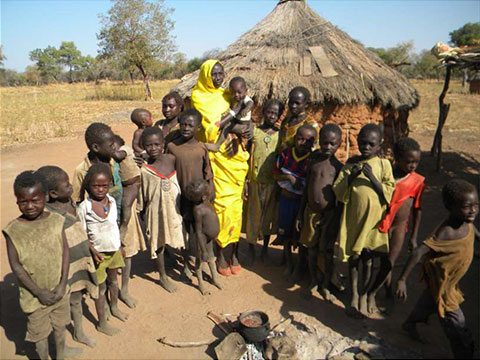
Executive Summary
For more than three years, South Kordofan state in Sudan has been the fighting grounds of an armed conflict between the Sudan Armed Forces (SAF) and the Sudan People’s Liberation Army-North (SPLA-N). This conflict has had a heavy cost on civilians living in the region, as they have had to endure heavy aerial bombardments, which have led to mass casualties, and have seriously disrupted farming and food production—the key livelihood activity and means of survival in the area.
In 2014, the government of Sudan scaled up its military offensive in the region and, beginning in April 2014, the area saw an upsurge of indiscriminate aerial bombardments that led to mass casualties and displacement, with many families fleeing the region into nearby foxholes and caves for shelter. Recently, civilian infrastructure, including farming plots, grain stores, health facilities, and water holes, have become the targets of aerial attacks, further harming the already vulnerable population living in the region.
In August 2014, a needs assessment was undertaken in the Sudan People’s Liberation Movement-North (SPLM-N) controlled areas of South Kordofan state to determine the humanitarian situation in the area and the needs of the conflict-affected population.
This assessment provides a picture of the widespread impact of the conflict on a variety of humanitarian indicators, including the nutritional status of children under five years of age. This assessment also compares select statistics to a similar assessment conducted a year ago, and generates relevant information to inform targeted response strategies.
The key assessment findings are as follows:
- Security concerns are an increasing threat to the population, demonstrated by 92% of displaced households fleeing due to fighting, up from 66% a year ago; 29% of the population has a family member currently living in a refugee camp and 79% of households state they do not feel safe at home—12% more than last year’s findings of 67%. Women and girls in focus group discussions claim sexual violence and rape are now serious concerns in the region, as a result of encroaching frontlines and proximity to enemy soldiers.
- Displacement is a major problem with 30% of the total population currently displaced from their homes—9% within the last eight months.
- Food security is poor with 80% of non-displaced households and 77% of displaced households showing unacceptable (either poor or borderline) food consumption scores. Seventy percent of displaced households and 64% of non-displaced households are experiencing moderate to severe hunger. To survive the lean season, families have employed various coping strategies; 65% of households are restricting food consumption of adults to feed children; 81% of households are reducing the number of meals consumed each week; and, 73% of families have been limiting their portion size at meals. Food stocks are a problem with 90% of households not having enough food stocks to last one month and 49% not having enough even for one week. Future food shortages are a concern, as cultivated land has declined. This year, households estimated that they cultivated an average of 1.57 feddans compared to 1.75 feddans a year ago, marking a 10% decrease. Prior to the war, households stated they were cultivating an average of 7.75 feddans.
- Malnutrition in the area is very high. Of note, there is a high prevalence of wasting indicated by a severe acute malnutrition (SAM) rate of 3.6% (2.8 – 4.6 95% confidence interval, C.I.), which is above the World Health Organization’s critical threshold level of 2%, and a global acute malnutrition (GAM) rate of 10.3% (9.0 – 11.9 95% C.I.) in children 6-59 months of age.
- Food purchased and produced varied between displaced and non-displaced households. Displaced households spent more on food purchases, and non-displaced households consumed a larger portion of food from home production. While households experiencing longer displacement spent more on farm input and housing, those displaced for less than eight months spent more on fuel, health, and food purchases.
- Markets were discussed in focus group discussions (FGD) and it was found that the population has very low purchasing power and only limited access to any markets; 26% of households state they have to walk at least an hour to get to a market.
- Education has been seriously impacted by the conflict. Fifty-three percent of households state that their children do not attend school regularly due to lack of money to pay school fees (37%) and insecurity (27%).
- Water, sanitation and hygiene (WASH) indicators are very low. Less than half—45%—of households are using an improved water source as their primary source; 25% of households have soap in their home and an overwhelming 86% of households are practicing open defecation.
- Health statistics were concerning with 51% of households stating at least one child had diarrhea in the preceding two weeks and 66% stating at least one child had malaria in the preceding four weeks. The majority of households—59%—did not have any mosquito nets for malaria prevention in their home.
Persistent insecurity has taken a heavy toll on the assessed population. Essential interventions are therefore required in food security, livelihoods, protection, health, and WASH. Recommended activities to immediately meet the urgent needs of the people living in the SPLMN controlled areas of South Kordofan state include:
- General food distributions and a malnutrition intervention;
- Agricultural support;
- Educational support;
- Advocacy to the international community for safety and security dialogue;
- Hand-pump repairs;
- Distribution of soap and jerry cans;
- Latrine construction;
- Provision of mosquito nets; and,
- Non-food items for recently displaced households.

